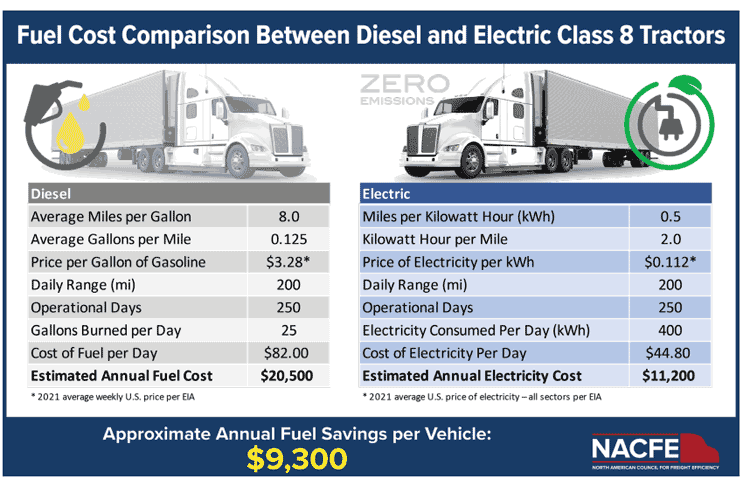A new report from the North American Council for Freight Efficiency (NACFE), based on results from last September’s Run on Less – Electric (RoL-E) freight efficiency demonstration, says a conservative 50% of regional hauls could use electric trucks right now.
Supply Chain Digest Says...
|
 |
| The report says that “the out-the-door price with help of credits, grants or other incentives may be similar, and the actual TCO over a five-year period of ownership will show the BEV (battery electric vehicles) is better.” |
 |
What do you say? |
| Click here to send us your comments |
 |
| Click here to see reader feedback |
|
The tests featured the four heavy-duty regional haul tractors that participated in the Run on Less demonstration: Anheuser-Busch with a BYD 8TT tractor; Biagi Bros. with a Peterbilt Model 579EV; NFI with a Volvo VNR Electric; and Penske with a Freightliner eCascadia.
The report also notes that all of the equipment used is in production (although volumes are limited at this time) and can be ordered today from the various manufacturers.
The report observes that defining a “regional haul” is difficult, and the research in the end broke it into three segments: maximum distances from depot of 50 miles termed short regional, 100 miles termed medium regional and 100 miles to 300 miles radius being long regional with return-to-base operations.
The report notes the various ranges for electric trucks, saying current market entrants are advertising vehicle one-charge ranges in nominal conditions of 150 miles to 250 miles.
The report states that “Battery electric vehicles (BEVs) are not a solution today to replace every diesel, but the segment hauling below 200 miles per day is a significant portion of the market, and BEVs are capable today in that range, even with heavy loads.
It also states there are many benefits to operators of electric trucks, including the potential for significant operating cost reductions, extended service intervals, less maintenance, improved ability to attract and keep drivers, better driver morale, and improved brand image.
The saving on fuel (electricity charging versus diesel) are substantial, averaging around $11,000 per year for electrics, as seen in the chart from the report below:

But the report notes there are also challenges with electrics. That starts with price points, which at a list price basis can be two to three times higher than a comparable diesel tractors.
(See More Below)
|
CATEGORY SPONSOR: SOFTEON |
|
|
| |
|
|
However, the report says that “the out-the-door price with help of credits, grants or other incentives may be similar, and the actual TCO over a five-year period of ownership will show the BEV is better.”
The report also cites issues with charging times (which can take several hours) and lack of charging infrastructure if needed on the road. Battery lifespan is also a potential (and significant) cost issue.
Netting it out, the report says “Heavy-duty regional haul battery electric trucks are viable solutions today for improving fleet freight efficiency and helping achieve sustainability goals on short and some medium length routes where daily mileage is 200 miles, with one shift return-to-base operations where overnight vehicle dwell time allows for lower cost overnight charging. Other variations of duty cycles also may be very viable where higher rate enroute charging can extend vehicle range.”
In fact, initially after the test in September, NACFE predicted that 70% of this market segment was electrifiable. Given a more detailed analysis, interviews with industry experts and further research for this report, NACFE now consider this market segment to be 50% electrifiable currently.
As noted above, the report says drivers prefer electrics, due to the drivability (particularly in getting up to speed), quietness and other aspects, which could improve driver attraction and retention for fleets that adopt electrics.
The full report is available here: Electric Trucks Have Arrived: The Use Case for Heavy-Duty Regional Haul Tractors
Any thoughts on this report and electrics? Let us know your at the Feedback section below.
|